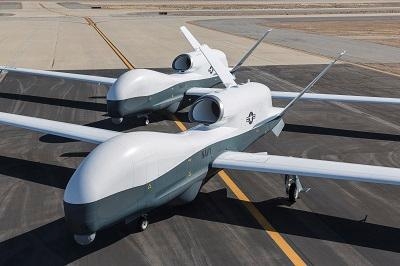Unmanned Patrol Squadron (VUP) 19 Will Operate Out Of Naval Air Station Jacksonville, Fla
The Navy stood up its first unmanned-only aviation squadron in late October, as the MQ-4C Triton community establishes its first operational squadron. VUP-19 will consist of only unmanned aircraft; a first for the Navy.

In a press release from the Pentagon as reported through USNI news, it’s announced that Unmanned Patrol Squadron (VUP) 19 will operate out of Naval Air Station Jacksonville, Fla., collocated with manned P-8A Poseidon squadrons. VUP-19 will consist of only unmanned aircraft, a first for the Navy, and will fall under Patrol and Reconnaissance Wing 11 with P-8 squadrons, Rear Adm. DeWolfe Miller (OPNAV N98) said Monday.
The official formation of the squadron, led by Cmdr. Benjamin Stinespring, will begin a long process of preparing for early operational capability and a first deployment to U.S. 7th Fleet in 2018, Miller explained, according to the report.
The squadron will receive its first vehicles in late 2017. It’s reported the approximately 130 squadron members have already begun rotating through Naval Air Station Patuxent River in Maryland to train with the test pilots stationed there. In January a Triton mission systems trainer will deliver to NAS Jacksonville to further train the air vehicle operators, and Naval Air Station Point Mugu in California has additional facilities to help train the maintainers, Miller said.
In addition to training, the VUP-19 crew will be tasked with collaborating with P-8 operators to develop tactics, techniques and procedures for operating the two maritime patrol/reconnaissance aircraft.
Miller reportedly said the Triton operators will have a good head start thanks to an understanding of what capability the MQ-4C brings to the fleet, as well as lessons learned from the teaming arrangement of the MQ-8 Fire Scout and the MH-60 – whose operators are grouped together in a common squadron, unlike the separate command structures for the MQ-4C and its manned partner.
While VUP-19 will have the freedom to write the TTPs as it sees fit, Miller noted that Triton’s predecessor, the Broad Area Maritime Surveillance Demonstrator (BAMS-D), has been operating in U.S. 5th Fleet for years, with the same maritime patrol/reconnaissance community gathering lessons learned along the way.
“We’ve learned a lot and that’s why we’re excited because we know what it has contributed as far as maritime awareness in the 5th Fleet area of operations. And so Triton is kind of a BAMS-D on steroids if you will, it incorporates many more sensors and the information that it will be able to provide to decision-makers will be far superior,” he said.
“And to now have this, or at least have the squadron in place that’s going to be delivering these capabilities to the fleet, is a significant milestone.”
Miller said the Navy had set this fielding effort up for success with a slow crawl/walk/run approach. The squadron stands up this week and will begin operating Tritons in the continental United States during early training and tactics development. By the time early operational capability rolls around in 2018, the squadron will be flying the air vehicles in and around Guam, and after an EOC declaration the vehicles would be moved as needed for 7th Fleet operations. The operators themselves will remain in Jacksonville at a vehicle control and information processing center, and a small detachment of maintainers will deploy forward to keep the air vehicles up and running. It has not yet been decided where the air vehicles will be stationed when not on deployment, USNI News understands.
After reaching EOC, a second squadron, VUP-11, will eventually be stood up at NAS Whidbey Island, Wash. The air vehicles themselves will also grow in capability, with more sensors being added until a future variant in the 2020 timeframe is ready to replace the manned EP-3E Aries II multi-intelligence reconnaissance aircraft, Miller said. He said the overall approach for Triton is “learn, grow, learn, grow.”
“It’s just exciting: we talk about man-machine teaming, we talk about our unmanned vehicles, and now here’s a milestone event where we’re standing up a squadron and it’s becoming a reality,” he said.
For more specific details and quotes, refer to the link below.
(Image from U.S. Navy)
 Airborne-Flight Training 05.09.24: ERAU at AIAA, LIFT Diamond Buy, Epic A&P
Airborne-Flight Training 05.09.24: ERAU at AIAA, LIFT Diamond Buy, Epic A&P ANN's Daily Aero-Term (05.07.24): Hazardous Weather Information
ANN's Daily Aero-Term (05.07.24): Hazardous Weather Information Aero-News: Quote of the Day (05.07.24)
Aero-News: Quote of the Day (05.07.24) NTSB Final Report: Cessna 150
NTSB Final Report: Cessna 150 Aero-News: Quote of the Day (05.08.24)
Aero-News: Quote of the Day (05.08.24)



